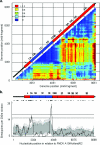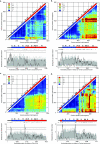Recombination patterns in aphthoviruses mirror those found in other picornaviruses - PubMed (original) (raw)
Recombination patterns in aphthoviruses mirror those found in other picornaviruses
Livio Heath et al. J Virol. 2006 Dec.
Abstract
Foot-and-mouth disease virus (FMDV) is thought to evolve largely through genetic drift driven by the inherently error-prone nature of its RNA polymerase. There is, however, increasing evidence that recombination is an important mechanism in the evolution of these and other related picornoviruses. Here, we use an extensive set of recombination detection methods to identify 86 unique potential recombination events among 125 publicly available FMDV complete genome sequences. The large number of events detected between members of different serotypes suggests that horizontal flow of sequences among the serotypes is relatively common and does not incur severe fitness costs. Interestingly, the distribution of recombination breakpoints was found to be largely nonrandom. Whereas there are clear breakpoint cold spots within the structural genes, two statistically significant hot spots precisely separate these from the nonstructural genes. Very similar breakpoint distributions were found for other picornovirus species in the genera Enterovirus and Teschovirus. Our results suggest that genome regions encoding the structural proteins of both FMDV and other picornaviruses are functionally interchangeable modules, supporting recent proposals that the structural and nonstructural coding regions of the picornaviruses are evolving largely independently of one another.
Figures
FIG. 1.
(a) Phylogenetic compatibility matrix of 125 FMDVs. To generate this plot, a 300-nucleotide window was moved across the alignment with 100-nucleotide steps, and at each position, a neighbor-joining tree was constructed. The compatibility of two trees is measured by the number of phylogenetic violations that are required to match the ordering of taxa within the tree. Obtained values are color coded, with phylogenetically compatible regions shown in blue. The FMDV genome diagram superimposed on the diagonal axis was drawn to scale relative to FMDV A10/Holland/62 (AY539751). (b) Potential recombination breakpoint hot spots within the FMDV alignment. Detectable breakpoint positions are indicated by small vertical lines at the top of the graph. A 200-nucleotide window was moved along the alignment 1 nucleotide at a time, and the breakpoints detected within the window region were counted and plotted (solid line). The upper and lower broken lines, respectively, indicate 99% and 95% confidence thresholds for globally significant breakpoint clusters. The light- and dark-gray areas, respectively, indicate local 99% and 95% breakpoint-clustering thresholds, taking into account local regional differences in sequence diversity that influence the abilities of different methods to detect recombination breakpoints (for a detailed description of the permutation test, see
http://darwin.uvigo.es/rdp/heath2006.zip
).
FIG. 2.
Phylogenetic-compatibility matrices and breakpoint density plots of enteroviruses and teschoviruses constructed as outlined for Fig. 1. (a) Enterovirus species A. (b) Enterovirus species B. (c) Enterovirus species C. (d) Teschoviruses. The superimposed genome diagrams were drawn to scale relative to sequences NC001430, NC001472, NC002058, and AJ011380. The upper and lower broken lines in each breakpoint density graph, respectively, indicate 99% and 95% confidence thresholds for globally significant breakpoint clusters. The light- and dark-gray areas, respectively, indicate local 99% and 95% breakpoint-clustering thresholds, taking into account regional differences in sequence diversity that influence the abilities of different methods to detect recombination breakpoints (
http://darwin.uvigo.es/rdp/heath2006.zip
). It should be noted that apart from a different color scale, the phylogenetic-compatibility analyses presented in panels a, b, and c are a repeat of those, using the same datasets, previously described by Simmonds and Welch (29) and are included here for comparative purposes.
Similar articles
- Recombination and selection in the evolution of picornaviruses and other Mammalian positive-stranded RNA viruses.
Simmonds P. Simmonds P. J Virol. 2006 Nov;80(22):11124-40. doi: 10.1128/JVI.01076-06. Epub 2006 Sep 6. J Virol. 2006. PMID: 16956935 Free PMC article. - Equine rhinovirus serotypes 1 and 2: relationship to each other and to aphthoviruses and cardioviruses.
Wutz G, Auer H, Nowotny N, Grosse B, Skern T, Kuechler E. Wutz G, et al. J Gen Virol. 1996 Aug;77 ( Pt 8):1719-30. doi: 10.1099/0022-1317-77-8-1719. J Gen Virol. 1996. PMID: 8760418 - Equine rhinovirus 1 is more closely related to foot-and-mouth disease virus than to other picornaviruses.
Li F, Browning GF, Studdert MJ, Crabb BS. Li F, et al. Proc Natl Acad Sci U S A. 1996 Feb 6;93(3):990-5. doi: 10.1073/pnas.93.3.990. Proc Natl Acad Sci U S A. 1996. PMID: 8577774 Free PMC article. - Recombination among picornaviruses.
Lukashev AN. Lukashev AN. Rev Med Virol. 2010 Sep;20(5):327-37. doi: 10.1002/rmv.660. Rev Med Virol. 2010. PMID: 20632373 Review. - Equine picornaviruses: well known but poorly understood.
Horsington J, Lynch SE, Gilkerson JR, Studdert MJ, Hartley CA. Horsington J, et al. Vet Microbiol. 2013 Nov 29;167(1-2):78-85. doi: 10.1016/j.vetmic.2013.05.012. Epub 2013 Jun 10. Vet Microbiol. 2013. PMID: 23820049 Review.
Cited by
- Genome and infection characteristics of human parechovirus type 1: the interplay between viral infection and type I interferon antiviral system.
Chang JT, Yang CS, Chen YS, Chen BC, Chiang AJ, Chang YH, Tsai WL, Lin YS, Chao D, Chang TH. Chang JT, et al. PLoS One. 2015 Feb 3;10(2):e0116158. doi: 10.1371/journal.pone.0116158. eCollection 2015. PLoS One. 2015. PMID: 25646764 Free PMC article. - Phylogenetic analysis of black queen cell virus genotypes in South Korea.
Noh JH, Reddy KE, Choe SE, Yoo MS, Doan HT, Kweon CH, Ramya M, Yoon BS, Nguyen LT, Nguyen TT, Van Quyen D, Jung SC, Chang KY, Kang SW. Noh JH, et al. Virus Genes. 2013 Apr;46(2):362-8. doi: 10.1007/s11262-012-0859-x. Epub 2012 Dec 14. Virus Genes. 2013. PMID: 23239276 - Bioinformatics and Molecular Analysis of the Evolutionary Relationship between Bovine Rhinitis A Viruses and Foot-And-Mouth Disease Virus.
Rai DK, Lawrence P, Pauszek SJ, Piccone ME, Knowles NJ, Rieder E. Rai DK, et al. Bioinform Biol Insights. 2016 Apr 4;9(Suppl 2):43-58. doi: 10.4137/BBI.S37223. eCollection 2015. Bioinform Biol Insights. 2016. PMID: 27081310 Free PMC article. - High Levels of Multiple Phage WO Infections and Its Evolutionary Dynamics Associated With _Wolbachia_-Infected Butterflies.
Gao S, Ren YS, Su CY, Zhu DH. Gao S, et al. Front Microbiol. 2022 Apr 21;13:865227. doi: 10.3389/fmicb.2022.865227. eCollection 2022. Front Microbiol. 2022. PMID: 35531293 Free PMC article. - Phylogenetic analyses of the polyprotein coding sequences of serotype O foot-and-mouth disease viruses in East Africa: evidence for interserotypic recombination.
Balinda SN, Siegismund HR, Muwanika VB, Sangula AK, Masembe C, Ayebazibwe C, Normann P, Belsham GJ. Balinda SN, et al. Virol J. 2010 Aug 23;7:199. doi: 10.1186/1743-422X-7-199. Virol J. 2010. PMID: 20731826 Free PMC article.
References
- Belsham, G. J. 2005. Translation and replication of FMDV RNA. Curr. Top. Microbiol. Immunol. 288:43-70. - PubMed
- Domingo, E. 2000. Viruses at the edge of adaptation. Virology 270:251-253. - PubMed
- Fauquet, C. M., M. Mayo, J. Maniloff, U. Desselberger, and L. A. Ball. 2005. Virus taxonomy. Eighth report of the International Committee on Taxonomy of Viruses. Academic Press, London, United Kingdom.
Publication types
MeSH terms
LinkOut - more resources
Full Text Sources

